1). “Federal Firings Threaten Great Lakes’ $5 Billion Fishery: Cuts to the U.S. Fish and Wildlife Service could unintentionally thwart efforts to control populations of the destructive sea lamprey”, Feb 27, 2025, Anika Jane Beamer, Inside Climate News, at < https://insideclimatenews.org/
2). “Sea Lamprey: The Greatest Invasive Control Success Story”, Jun 12, 2017, Kevin Bunch, International Joint Commission, Newsletter, at < https://www.ijc.org/en/sea-
3). “Sea Lamprey Control in the Great Lakes: A remarkable success!”, N.D., Anon, Great Lakes Fishery Commission, at < https://www.glfc.org/control.
4). “Combating a Great Lakes invader with new technologies: The fight against invasive sea lamprey”, N.D., Monica Blaser, U.S. Fish and Wildlife Service, at < https://www.fws.gov/story/
5). “Sea Lamprey: The Battle Continues to Protect Our Great Lakes Fishery”, May 4, 2018, Anon, Government of Canada, at < https://www.dfo-mpo.gc.ca/
~~ recommended by dmorista ~~
Yesterday I noted a link to “The Great Lakes”, in the 3rd paragraph of an article here at The Class Struggle (that opens with the phrase “He’s taking a sledgehammer ….”). The link was one of many in a sentence in that paragraph, that is in the article “The only thing Elon wants to eliminate is your ability to rule yourself: ….”, the second of two articles in “The Threat of Elon Musk”, posted here at The Class Struggle on Sunday, March 2, 2025.
I clicked on that link and it took me to Item 1)., “Federal Firings Threaten Great Lakes’ ….” that discusses the danger that that action poses to the Lamprey Control operation on the Great Lakes. Neither Elon Musk, nor Donald Trump nor any of their minions (including the extremist computer college students who have been cutting funding and firing federal workers) has any understanding of what is actually going on in the waters of the Great Lakes, and their tributaries. In fact one of Trump's earliest actions, taken in 2017, during his first term was to try to cut the monies the Federal Government spent of the Great Lakes from $600 million to $50 million. That ran into a unified congressional response by the senators and representatives, from both duopoly parties, demanding that the funding be restored, which was quickly done.
Item 1). points out that Now:
“Sweeping layoffs of federal employees have struck the program responsible for controlling the invasive sea lamprey that threatens fish across the Great Lakes, the earth’s largest freshwater ecosystem.
“Among hundreds of U.S. Fish and Wildlife Service (USFWS) employees terminated this month were 12 members of the Great Lakes sea lamprey control program, based at field stations in Marquette and Ludington, Michigan.”
The staffing cuts (12 out of a total workforce of 85, or 14%) will make it more difficult to control the Lampreys. Before effective control was established the invasive Sea Lampreys decimated the fish populations of the Great Lakes, reducing the catch to below 5% of pre-infestation levels.
Item 1). continues on to report that the cutbacks will reduce the effectiveness of the use of the Lampricide TFM that is used in areas where Lampreys are known to breed and produce millions of young:
“Each year, the commission contracts with USFWS to spread pesticide targeting the larvae of lamprey. In Michigan, the fish and wildlife control team distributes a chemical known as TFM in rivers and tributaries where lamprey are known to lay their eggs.
“Left unchecked, lamprey larvae grow into parasitic adults that wreak havoc on aquatic ecosystems. With a toothy, suction-cup mouth it uses to latch onto other fish, a single lamprey can consume 40 pounds of fish in just one year. 'They’re nasty little critters, and they do horrific damage to an ecosystem,' said Greg McClinchey, director of policy and legislative affairs for the Great Lakes Fishery Commission.
“Prior to TFM’s discovery in the late 1950s, the commission’s job was herculean. But armed with the highly effective pesticide and some seasonal hires, it has been able to control lamprey populations with a relatively lean team. Each year, team members kill over five million larvae that would otherwise survive and spawn in the Great Lakes. Staffing cuts throw a wrench in that work: The biological technicians laid off during the Trump administration’s push for big cuts to the federal government represent about 14 percent of the lamprey control program’s overall workforce.
“Cutting back the control program by one-sixth would allow over one million lamprey to survive, McClinchey estimated. Those lamprey would eat nearly five million pounds of fish, equalling $105 million in lost economic output and potential, far outstripping the cost of the workers’ salaries. (Emphasis added) ….
“Just a week ago, the Great Lakes Fishery Commission faced a more dire staffing situation, as the USFWS informed directors they’d also be unable to hire seasonal workers to spread lampricide come April. Within a few days, that hiring freeze was reversed, said McClinchey. ….
“McClinchey is currently in D.C. for appropriation season, presenting the commission’s work to members of Congress and defending the agency’s budget. It’s an annual trip, but this year he’s also advocating for the reinstatement of laid-off lamprey control employees.”
Item 2)., “Sea Lamprey: The Greatest ….”; Item 3)., “Sea Lamprey Control ….”; Item 4)., “Combating a Great Lakes invader ….”; and Item 5)., “Sea Lamprey: The Battle Continues ….”; are all short and discuss various aspects of the Sea Lamprey Control operations. The control established over the Sea Lamprey stands as the most successful program to control a problematic invasive exotic in human history. Not only is TFM successfully used, but also the fact that its use has been reduced by implementation of other techniques that are discussed in those articles.
The Laurentian Great Lakes (herinafter, referred to as the N.A. Great Lakes) have plenty of other environmental problems. There are a number of other invasive species, including the Grobi, and the Zebra and Quagga Mussels. The Asian Carp is approaching the lakes with the most immediate and acute danger coming from the locks on the Chicago River. That channel was engineered to flow towards the Mississippi River (the reverse of the natural flow). Electric Gates are installed there, but many biologists and environmentalists have been recommending that the Army Corps of Engineers should cut the connection between the Mississippi and Lake Michigan to avoid a breach of the electric gate. There are many more exotic species problems and various types of pollution and poor land use practices along the shorelines. For Example, why the Canadian Government has chosen to store nuclear waste right on the shores of Georgian Bay is a mystery to me. There are also petroleum problems with two pipeline crossings in the waters of the Great Lakes, one at the Straits of Mackinac and one at Port Huron / Sarnia that crosses the waters of Lake Huron.
Map 2: Cumulative Environmental
Impacts on the Great Lakes
(Map 2 source: “Mapping the human impact on the Great Lakes”, Mar 22, 2017, Nick Walker, Canadian Geographic, at < https://www.canadiangeographic.ca/article/mapping-human-impact-great-lakes >)
Map 3: Various Petroleum Operations That Threaten the Great Lakes
(Map 3 Source: at <https://www.petoskeynews.com/michigan-great-lakes-at-risk-for-oil-spills-beyond-line/article_11500183-4e39-5534-8eb0-e9c325d50c8b.html >: Location of “Port Huron, Mich / Sarnia, Ontario Pipeline Crossing” in Lake Huron Water added by author)
In reality the North American “Laurentian Great Lakes” are one of three systems of giant freshwater lakes on Earth; and while the three systems are all similar in scale the N.A. Great Lakes contain the smallest volume of water of the three systems. “The African Great Lakes (AGL) ecosystems have a combined catchment area spanning over 850,000 km2 across seven major lake basins, namely: Lakes Albert, Edward, Kivu, Malawi/Nyasa/Niassa, Tanganyika, Turkana, and Victoria in East and Central Africa”, this compares to an area of 246,463 km2 in the combined N.A. Great Lakes / St Lawrence River Watershed. (See, Kevin Obiero et. al., “Advancing Africa’s Great Lakes research and academic potential: Answering the call for harmonized, long-term, collaborative networks and partnerships”, Journal of Great Lakes Research, Volume 46, Issue 5, Oct 2020, Pages 1240-1250, {abstract only} at < https://www.sciencedirect.com/
Map 4: The Three Great Lake Systems of the World
(Map 4 Source: Great Lakes Index, Global Great Lakes, at <
https://www.globalgreatlakes.org/index.html >)
The issues of water supply and access will only continue to grow in importance and severity as time passes. Continued agricultural, industrial, and municipal uses will keep reducing the amount of water available per capita. In North America we are living in a continent with huge water resources, the best in the world in fact. But the development and migration trends of the past 50+ years in the U.S. have moved people from places with adequate water supplies to places without adequate water supplies. It is unconscionable to neglect the health and condition of the incredible gift of the Great Lakes. Most of the world can only dream of such a wealth of fresh water.
xxxxxxxxxxxxxxxxxxxxxxxxxxxxxxxxxx
Federal Firings Threaten Great Lakes’ $5 Billion Fishery - Inside Climate News

Sweeping layoffs of federal employees have struck the program responsible for controlling the invasive sea lamprey that threatens fish across the Great Lakes, the earth’s largest freshwater ecosystem.
Among hundreds of U.S. Fish and Wildlife Service (USFWS) employees terminated this month were 12 members of the Great Lakes sea lamprey control program, based at field stations in Marquette and Ludington, Michigan.
These staffing cuts could have grave consequences for the lakes’ native fish population and the $5 billion fishery they comprise.
For over seven decades, the binational Great Lakes Fishery Commission has been tasked by both Canada and the United States with controlling the lamprey population throughout the lakes.
We’re hiring!
Please take a look at the new openings in our newsroom.
Each year, the commission contracts with USFWS to spread pesticide targeting the larvae of lamprey. In Michigan, the fish and wildlife control team distributes a chemical known as TFM in rivers and tributaries where lamprey are known to lay their eggs.
Left unchecked, lamprey larvae grow into parasitic adults that wreak havoc on aquatic ecosystems. With a toothy, suction-cup mouth it uses to latch onto other fish, a single lamprey can consume 40 pounds of fish in just one year. “They’re nasty little critters, and they do horrific damage to an ecosystem,” said Greg McClinchey, director of policy and legislative affairs for the Great Lakes Fishery Commission.
Prior to TFM’s discovery in the late 1950s, the commission’s job was herculean. But armed with the highly effective pesticide and some seasonal hires, it has been able to control lamprey populations with a relatively lean team. Each year, team members kill over five million larvae that would otherwise survive and spawn in the Great Lakes. Staffing cuts throw a wrench in that work: The biological technicians laid off during the Trump administration’s push for big cuts to the federal government represent about 14 percent of the lamprey control program’s overall workforce.
“We don’t do politics. We don’t do that partisan stuff,” McClinchey said. “But we can speak to outcomes. And when you take 12 people out of a group of 85, that’s going to have an impact.”
Cutting back the control program by one-sixth would allow over one million lamprey to survive, McClinchey estimated. Those lamprey would eat nearly five million pounds of fish, equalling $105 million in lost economic output and potential, far outstripping the cost of the workers’ salaries.
Historically, the lamprey control program has garnered unanimous bipartisan support. “The program is obviously really effective, and so it has a lot of support across the board,” said one technician laid off from the USFWS field station in Marquette, Michigan.
She asked to remain unnamed, concerned that speaking to the press might impact her ability to return to USFWS in the future. Ten months into a career position at USFWS and two years into work at the agency, she was laid off on Feb. 14. “There is this culture of, ‘Oh, we’re immune to these actions by the federal government,’ but that’s obviously not the case here,” she said.
“We don’t do politics. We don’t do that partisan stuff. But we can speak to outcomes. And when you take 12 people out of a group of 85, that’s going to have an impact.”
— Greg McClinchey, Great Lakes Fishery Commission
Leading up to the layoff, supervisors informed her and all of her colleagues in probationary roles—those who’ve held their current position for less than 12 months—that they were at risk.
The worker said her supervisor was apologetic when she called with news of the layoffs. But when she received her official letter of termination in the mail on Monday, the tone was different. “The Department has determined your knowledge, skills, and abilities do not meet the Department’s current needs, and it is necessary and appropriate to terminate, during the probationary period, your appointment to the US Fish and Wildlife Service,” the letter said.
Her performance reviews for the last year had been glowing, so the letter made no sense. “It’s not a real explanation,” she said.
The USFWS layoffs will not affect the sea lamprey control program in Canada, McClinchey said. “The Canadian government has assured us that the money from Canada will continue to be there and we’re on track to deliver a full program in Canadian waters,” he said. “That’s great, but this program works because it’s border blind.”
In other words: Cuts to lamprey control in U.S. waters are a threat to fish and fishermen everywhere on the Great Lakes.
Just a week ago, the Great Lakes Fishery Commission faced a more dire staffing situation, as the USFWS informed directors they’d also be unable to hire seasonal workers to spread lampricide come April. Within a few days, that hiring freeze was reversed, said McClinchey.
This reversal gives him a bit of hope. “That at least tells us no one is rooting for the lamprey,” he said.
McClinchey is currently in D.C. for appropriation season, presenting the commission’s work to members of Congress and defending the agency’s budget. It’s an annual trip, but this year he’s also advocating for the reinstatement of laid-off lamprey control employees.
He is optimistic. “It seems clear to me that it’s important we preserve this program, and so far everyone we’ve encountered thinks that way and are working to that end,” he said.
Cutting back the program isn’t really on the table for the commission. Even minor cuts to scope would be devastating for the fishery, he said.
Even the former USFWS employee from Marquette is remaining hopeful. “I still think that they’re going to scramble to make it happen,” she said. “Because it’s not really an option to just stop treating for a whole season.”
This story was corrected Feb. 28, 2025, to remove references to the sea lamprey as a type of eel. Though it resembles an eel, it is a fish.
xxxxxxxxxxxxxxxxxxxxxxxxxxxxxxxxxxxx
Sea Lamprey: The Greatest Invasive Control Success Story | International Joint Commission

An invader in a massive freshwater basin. An uncountable number of spawning grounds. A fishery on the brink. A desperate search for a solution that ended up becoming the most successful aquatic invasive species control team effort in American and Canadian history. It’s not a movie, but rather the true tale of the sea lamprey’s invasion of the Great Lakes.
The sea lamprey is parasitic fish native to the Atlantic Ocean. As an adult, it latches onto other fish with its suction cup-like mouth, using a rasping tongue to cut into its victim to suck out bodily fluids and blood. In the Atlantic it doesn’t typically kill its hosts, but the fish in the Great Lakes have no such luck. It’s estimated that a single lamprey can destroy an average of 18 kilograms (39 pounds) of fish in its parasitic lifetime, with only about one in seven fish surviving a lamprey attack. It’s not to be confused with native lamprey, which are smaller and have different coloration, and don’t usually kill the host fish.
Sea lampreys were first detected in Lake Ontario in 1835. While there has been discussion on whether it is native to Lake Ontario, it most likely is an invasive species that entered through the Erie Canal, according to Marc Gaden, communications director for the Great Lakes Fishery Commission (GLFC), a binational organization funded by the Canadian and US governments. The 1919 reconstruction of the Welland Canal, which bypasses Niagara Falls to connect Lake Ontario to Lake Erie, likely allowed the sea lamprey to enter Lake Erie and on to the rest of the basin. They were discovered in Lake Erie in 1921, Lake Michigan in 1936, Lake Huron in 1937 and Lake Superior in 1939. The sea lamprey found an immense number of tributaries featuring the combination of rocky nesting grounds to lay eggs and silt for larval lampreys to grow in, making the Great Lakes a lamprey Eden. In its native habitat, the sea lamprey spends most of its life in saltwater, making it the rare species that has adapted to living entirely in freshwater systems like the Great Lakes, similar to the Pacific salmon species introduced to control invasive alewives.
The impact on the Great Lakes fishery was devastating. Prior to the invasion, about 20 million pounds or about 9 million kilograms of fish were harvested commercially each year in the upper Great Lakes – Superior, Huron and Michigan. By the 1960s that amount was reduced to about 300,000 pounds (136,077 kg) per year, while sea lamprey were killing close to 100 million pounds (45.4 million kg) of fish each year, and 85 percent of the remaining fish were scarred with lamprey attack wounds.
“Commercial fishermen and fishery managers first realized they had a problem around 1940, when it became clear what was happening to the Huron-Michigan fisheries from lamprey,” Gaden said. “That’s when the managers and scientists went into high gear and started seeking control measures.”
With little experience with aquatic invasive species, a wide variety of control methods were attempted. These methods included physical barriers to keep lamprey from entering the streams they use to spawn, crude electrical barriers to block their advances and sieves to stop larvae from eventually entering the Great Lakes from those inland streams. Entrepreneurs tried to make sea lamprey a commercially fished species for human consumption, but none of these attempts worked in stopping the sea lamprey.
The breakthrough came after years of searching for a chemical compound that would kill sea lamprey and not harm other organisms. A compound called TFM was discovered and field-tested in 1957, and entered management usage in 1958 through the binational GLFC. It has been used to great success.
The lampricide targets larval sea lampreys living in streams. After hatching from eggs found upstream in rocky areas, larvae make their way to silty areas and burrow into the substrate until they emerge as adults. The lampricide kills them in that weak, larval state by disrupting their metabolism before they can ever grow up to become the top predator in the Great Lakes. After decades of use, Gaden said the sea lamprey population in the Great Lakes has been reduced by about 90-95 percent from their peak in the late 1950s, and dropped the amount of fish killed by the lamprey to about 10 million pounds (4.5 million kg) a year. While it also affects native lamprey species, sea lamprey larvae tend to live and spawn in different areas from the native species; fishery managers focus on those stream areas where sea lamprey larvae burrow to minimize the impact on native species.
Lampricide isn’t the only tool used to control lamprey numbers, Gaden said, as good pest control takes multiple tacks. Physical barriers are still in use to deny lampreys a path to their preferred spawning grounds. And if those lampreys can’t reach a place to spawn, there’s no need use lampricide treatments, which is expensive and time-consuming. The GLFC also deploys traps to catch lamprey entering or leaving the streams to remove them from the system, and has tested sterilizing male lamprey in the St. Marys River to try and overwhelm the number of fertile males. Most recently, Gaden said the GLFC “is on the cusp” of using isolated lamprey pheromones to affect their behavior – drawing lamprey away from ideal spawning locations and toward traps.
“We’re working on unlocking their genome,” Gaden said. “There are things within the lamprey genome we can exploit, like create conditions so they only produce males, but that’s further into the future.”
Mark Burrows, physical scientist and project manager in the IJC’s Great Lakes Regional Office, said the GFLC has sponsored important research devoted to controlling and eradicating sea lampreys while protecting native species, much of which was highlighted at the recent International Association for Great Lakes Research conference in Detroit.
“They deserve a lot of praise for the progress they have made in combatting this destructive invasive species, and I look forward to the GLFC forging another 10-fold decrease in lamprey numbers at some point in the future,” Burrows said.
While a focused and targeted approach to invasive species can work in smaller inland lakes, the size of the Great Lakes makes controlling aquatic invaders difficult. That they invaded a waterway that also serves as a border between Canada and the United States added an additional wrinkle. It meant both countries needed to work together, even though fishery management is primarily the domain of state, province, tribal and First Nation governments. This team effort has kept sea lamprey from completely dominating the ecosystem of the Great Lakes for decades.
Great Lakes Fishery Commission - Control
Sea Lamprey Control in the Great Lakes:
A remarkable success!
The sea lamprey is an incredibly destructive invasive species. Since entering Lake Ontario in the mid-1800s, and the upper Great Lakes beginning in 1921, sea lampreys have inflicted significant economic damage, harmed the fishery and ecosystem, and changed the way of life in the region.
Of the more than 180 non-native species in the Great Lakes basin, sea lampreys are the only invader that is controlled basin-wide and is the only example in the world of a successful aquatic vertebrate pest control program at an ecosystem scale.
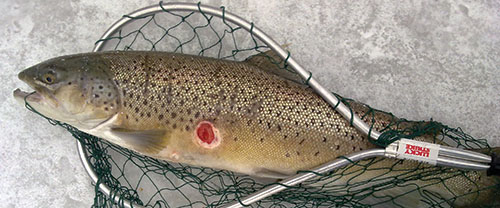
Sea lampreys must be controlled to maintain and improve the fishery as we know it and to protect the integrity of the ecosystem. The good news is they can be controlled! The Great Lakes Fishery Commission, pursuant to the Convention on Great Lakes Fisheries, delivers sea lamprey control in partnership with the U.S. Fish and Wildlife Service, Fisheries and Oceans Canada, and the U.S. Army Corps of Engineers. The U.S. Geological Survey conducts critical sea lamprey research to aid in control. This control program has reduced sea lamprey populations by 90% in most areas of the Great Lakes, a remarkable success!
How are sea lampreys controlled?
Sea lampreys spend a significant portion of their lives in tributaries as filter feeding larvae, so sea lamprey control begins when biologists assess tributaries to determine which ones contain larval sea lampreys. Larval assessment is critical in determining the presence, distribution, size structure, and abundance of larval sea lampreys in infested tributaries. This information helps the commission decide where and when control should be implemented. Sea lamprey control works because the commission has several tools available to significantly knock-down the populations.
The commission and its partners maintain an "integrated" sea lamprey control program that combines several control methods to attack sea lampreys on many fronts. These methods include:
Lampricides
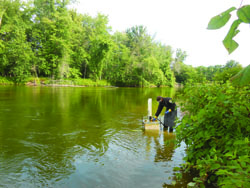
The primary method to control sea lampreys is the application of the lampricide TFM to target sea lamprey larvae in their nursery tributaries. In the concentrations used, TFM kills larvae before they develop lethal mouths and migrate to the lakes to feed on fish, while most other organisms are unaffected by TFM. TFM disrupts energy metabolism in sea lampreys, which have low levels of the enzymes used to eliminate TFM from their bodies. Another compound called Bayluscide is less costly and during some treatments, a liquid or powdered form of Bayluscide is combined with TFM to reduce the amount of TFM needed during treatments. Additionally, a granular form of Bayluscide, consisting of Bayluscide-coated grains of sand covered with a time-release coating, is applied to slow-moving or stationary waters where it sinks to the bottom before releasing its payload. This enables control of larvae in areas where TFM cannot be used. About 200 Great Lakes tributaries and larval "hot spots" are regularly treated with lampricides to kill larvae before they have a chance to prey on fish.
Barriers
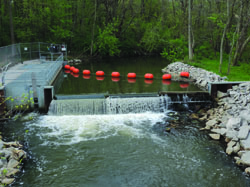
To successfully reproduce, sea lampreys require access to tributaries containing spawning gravel and soft substrates for larval sea lampreys to burrow into. The jumping ability of adult sea lampreys is limited, so barriers function to block adult access to spawning habitat and, therefore, reduce the amount of habitat that sea lampreys can infest. In addition to power generating and other dams, low-head barriers specifically designed to block adults have been constructed in strategic locations around the Great Lakes. Most low-head barriers allow jumping fish to pass while other barriers incorporate "trap and sort" fishways, which permit the passage of non-jumping species (trapped sea lampreys are removed). Barriers have reduced or eliminated the need for lampricide treatments in thousands of miles of tributaries.
Traps
Sea lampreys are vulnerable to capture as adults when they move into tributaries to spawn or as juveniles when they move out of tributaries to prey on fish. Adult traps are typically built into or placed immediately downstream of sea lamprey barriers and capture up to 40% of the adult population from a tributary. Unfortunately, traps typically do not capture a high enough proportion of the adult population to eliminate reproduction entirely or the subsequent need for lampricide treatments. Nevertheless, trapping provides a critical way to assess adult populations and gauge the success of the sea lamprey control program. Juvenile traps are typically free-standing, removable nets or other devices that target sea lampreys before they kill fish.
Pheromones and alarm cues
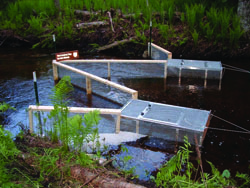
Sea lampreys have an extremely keen sense of smell, and since the 1990s, the commission and its research partners have been developing ways to exploit that sense for sea lamprey control. Pheromones and alarm cues are natural odors organisms use to affect certain behaviors or physiological functions. Sea lampreys emit pheromones to attract adults to suitable spawning tributaries and to mates within the tributary. Alarm cues emanate from dead or injured sea lampreys and warn other sea lampreys of impending danger, causing a flight response. Together, pheromones and alarm cues could be used in a "push-pull" technique—luring adults to traps, unsuitable spawning habitat, and areas that are easy and inexpensive to treat with lampricides, and repelling them from areas with productive spawning habitat and areas where control tactics are hard or expensive to implement.
The fishery depends on sea lamprey control. Fish are part of the fabric of the Great Lakes.
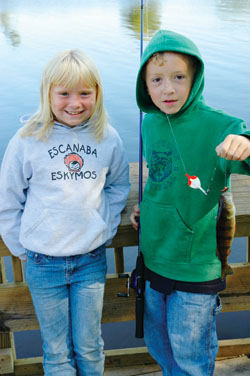
- The Great Lakes fishery is worth more than $7 billion annually.
- The fishery supports 75,000 jobs, in addition to hundreds of thousands of jobs related to tourism, navigation, etc.
- More than 5 million people fish the Great Lakes annually.
- Commercial fishing is the backbone of many Great Lakes communities. Charter fishing is an important business.
- Subsistence fishing is a right and a way of life for tribal and aboriginal communities.
Sea lamprey populations have been reduced to a fraction of what they were before control began, creating conditions for the recovery of native and desirable fishes and the ecosystem. Today, agencies stock hundreds of millions of trout and salmon into the lakes, enhancing the resource.
Sea lamprey control must continue.
Sea lamprey control is a major contributor to the value of the Great Lakes fishery. Sea lampreys are resilient beasts. When control is relaxed for even a short time, they bounce back with a vengeance and inflict major harm. Elevated sea lamprey abundances take years to remedy and higher populations set back fishery and ecosystem recovery by decades.
Robust, ongoing control is essential.
History shows that with fewer fish, the region’s economy and environment suffer greatly:
- More sea lampreys mean a degraded ecosystem, increased damage to the fish community, and fewer fish.
- The people who depend on the $7 billion fishery suffer economically when sea lampreys prey on Great Lakes fish.
- Waterfront communities decay and people move away.
- More sea lampreys jeopardize tribal treaty obligations.
- xxxxxxxxxxxxxxxxxxxxxxxxxxxxxxxx
Combating sea lamprey in the Great Lakes with new technologies | U.S. Fish & Wildlife Service
From land to waterways, we at the U.S. Fish and Wildlife Service work alongside partners to combat self-sustaining populations of invasive species , such as sea lamprey. Our invasive species efforts are a critical component in native species conservation and our research is essential in our conservation outcomes.
The Great Lakes formed more than 10,000 years ago as glaciers receded at the end of the last ice age. These vast inland seas form the largest surface freshwater system on Earth and support 139 native fish species including lake trout, a prized game and food fish. This freshwater fish is a top predator in the Great Lakes and was commercially harvested on massive scales until the fishery collapsed in the 1950s from a combination of overfishing, pollution, loss of spawning habitat and parasitism by invasive sea lamprey.
Invasive sea lampreys are a jawless, parasitic fish native to the Atlantic Ocean that entered the Great Lakes system via manmade locks and shipping canals. Their aggressive behavior and appetite for the bodily fluids of fish wreaked havoc on native fish populations and decimated an already vulnerable lake trout fishery.
Sea lamprey control is a critical component of fisheries management in the Great Lakes, benefiting important fish stocks by significantly reducing the number of fish killed by sea lamprey. The U.S. Fish and Wildlife Service and Fisheries and Oceans Canada implement sea lamprey control in the Great Lakes, while the Great Lakes Fishery Commission coordinates and funds the control program.
Sea lamprey control technologies
The diversity of sea lamprey control technologies has grown since the start of the program in 1953. The evolution of our research helps us to better understand this invasive species and protect aquatic resources. We are advancing technologies across the Great Lakes region that will benefit the future of aquatic conservation.
In the 1950s, we worked to identify a pesticide, known as a lampricide, effective at controlling sea lamprey larvae without significantly impacting other species. Scientists tested nearly 6,000 chemical compounds before identifying a lampricide known as TFM. Biologists apply TFM to lamprey-infested streams in the Great Lakes to reduce larval sea lamprey populations. We have used TFM successfully for more than 60 years to suppress sea lamprey populations in the Great Lakes.
Traps and nets are standard tools in capturing sea lamprey to assess adult sea lamprey abundance. We operate traps and nets in about 40 tributaries in the Great Lakes in partnership with tribal nations during the spring and early summer. Additionally, there are more than 30 barriers on Great Lakes streams in the United States that block migrating sea lampreys from reaching spawning locations. We work with partners to maintain and implement barriers in streams when other control options are not feasible, too expensive or ineffective.
Working closely with the U.S. Army Corps of Engineers, we are researching novel barrier designs. Corps engineers incorporated sea lamprey swim performance data when redesigning a dated Harpersfield Dam along the Grand River in Geneva, Ohio. The new stepped design concept used for the dam has been proposed for several new feasibility studies. The design includes permanent attractant-water sea lamprey traps with low-flow channel entrances and a lampricide delivery system for more effective application of lampricides downstream of the barrier.
Collaborating with partners on research
Our collaboration with partners is a valuable part of our work. Alongside our partners, we are researching improvements to selective fish passage , identifying supplemental control techniques and supporting research on the next generation of lampricides.
As part of FishPass, a selective fish passage project led by the Great Lakes Fishery Commission in partnership with federal, tribal, state and local governments and natural resource agencies, our biologists consult on project planning including site selection and trap designs. FishPass replaces the deteriorating Union Street Dam in Traverse City, Michigan, on the Boardman River with a new barrier. Below the new barrier, scientists will test technologies and techniques that can sort and pass desirable fishes without allowing harmful invaders like sea lampreys through. Once the project is completed, we will provide larval and adult assessments upstream and downstream of the facility and will be among the first to field test any new technologies developed as part of the project.
Supplemental control techniques such as attractants and repellents could guide sea lamprey towards traps or away from suitable spawning habitats. Supplemental controls are being researched and tested to enhance control where physical, biological or social challenges limit the effectiveness of lampricides or barriers.
Partnering with the U.S. Geological Survey and Department of Fisheries and Oceans Canada, we are testing and evaluating supplemental control tools in a multi-decade adaptive management project. The study will be conducted on a dozen streams in northern Michigan and Ontario, Canada, for a dozen years and is designed to increase confidence in our understanding of where and when removal of an adult sea lamprey results in fewer future larvae.
We support the investigative work of the U.S. Geological Survey’s Upper Midwest Environmental Sciences Center in developing the next generation of lampricides. Our biologists will test possible alternative lampricides to TFM in the field after researchers at the center have completed laboratory tests. This field research will help verify successful alternative lampricides for possible future use.
Using the best available science we are driving technological innovation in sea lamprey control. We are far from alone in our efforts, working closely with partners to enhance existing control techniques and develop new control methods effective at stopping invasive sea lamprey. Approaching sea lamprey control from multiple angles has reduced sea lamprey populations in the Great Lakes basin, creating favorable conditions for the recovery of native fishes like lake trout. Continued sea lamprey control will help preserve a healthy Great Lakes ecosystem.
xxxxxxxxxxxxxxxxxxxxxxxxxxxxxxxxxxx
The Battle Continues to Protect Our Great Lakes Fishery
1. Our Great Lakes Fishery: A Shared Resource
The Great Lakes are a valuable resource shared by Canada and the United States. More than 40 million people depend on the Great Lakes for food, drinking water, and recreation. The fishery alone generates up to $7 billion for the region annually, offering recreational angling opportunities for five million people and providing 75,000 jobs.
The health of the Great Lakes fishery is under constant threat from habitat loss, pollution, and invasive species including sea lampreys. Through stewardship and cooperation, we are tackling some of our biggest challenges. Sea lamprey control is one area where we are winning the battle.
1.1 What are Sea Lampreys?
Sea lampreys are primitive fish native to the Atlantic Ocean. In the Great Lakes they have no commercial value and fish do not normally feed on them.
Lacking jaws, their round mouths form a sucking disk filled with sharp, horn-shaped teeth that surround a rasping tongue. Unlike most fish, a lamprey's body has cartilage but no bones, scaleless skin, no paired fins, no lateral line, and no swim bladder.
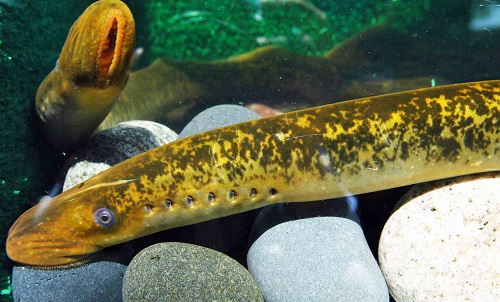
Sea lamprey. Photo credit: Great lakes Fishery Commission. 1.2 Where are Sea Lampreys found?
Sea lampreys entered the Great Lakes from the Atlantic Ocean through man-made shipping canals and were first observed in Lake Ontario in the 1830s. Niagara Falls acted as a natural barrier preventing sea Lamprey movement to Lakes Erie, Huron, Michigan, and Superior. However, when the Welland Canal (constructed to bypass the falls) was deepened in 1919, sea lampreys gained access to the rest of the Great Lakes. By 1938, they had invaded all of the Great Lakes.

Mouth of a Sea lamprey. Photo credit: Great lakes Fishery Commission. 1.3 What damage do Sea Lampreys inflict on the fishery?
Sea lampreys are parasitic pests. They attach to fish with their suction mouth and teeth, and use their tongue to rasp through a fish’s scales and skin so they can feed on its blood and body fluids. A single sea lamprey will destroy up to 18 kgs (40 lbs.) of fish during its adult lifetime. Sea lampreys are so destructive that, under some conditions, only one out of seven fish attacked will survive. Sea lampreys prey on all types of fish, such as lake trout, salmon, rainbow trout (steelhead), brown trout, whitefish, yellow perch, burbot, walleye, catfish, and even sturgeon.
In the 1940s and 1950s, sea lamprey populations exploded as there were no effective control methods and no natural predators. This contributed significantly to the collapse of fish species that were the economic mainstay of a vibrant Great Lakes fishery. For example, before sea lampreys entered the Great Lakes, Canada and the United States harvested about 7 million kgs. (15 million lbs.) of lake trout in lakes Huron and Superior annually. By the early 1960s the catch was only about 136,000 kgs. (300,000 lbs). The fishery was devastated.
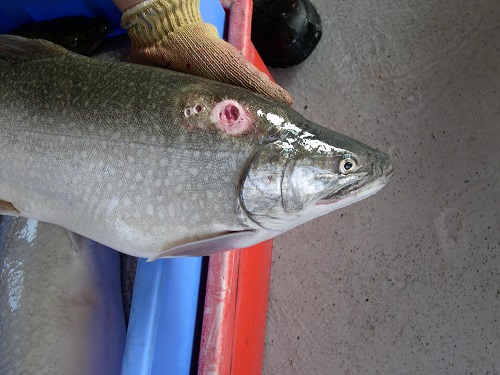
A wound left on a Lake trout by a Sea Lamprey. Photo credit: Fisheries and Oceans Canada. 2. How are Sea Lampreys controlled in the Great Lakes?
The Great Lakes Fishery Commission, in cooperation with Fisheries and Oceans Canada, the U.S. Fish and Wildlife Service, and the U.S. Army Corps of Engineers, carry out sea lamprey control on the Great Lakes. The U.S. Geological Survey conducts critical sea lamprey research. The control program uses several techniques to attack sea lampreys during different stages of the life cycle.
2.1. Lampricides
Sea lamprey control begins when biologists go into the field and determine which streams contain sea lamprey larvae. This assessment data is then used to help the commission decide which streams to treat with lampricides.
Currently, the primary method to control sea lampreys is a lampricide called TFM. TFM kills sea lamprey larvae in streams with little or no impact on other fish and wildlife. After extensive testing, which began in the 1950s, scientists determined that TFM is non-toxic or has minimal effects on aquatic plants, invertebrates, fish, and wildlife. It is not harmful to humans or other mammals at the concentration applied. A solid form of lampricide, known as granular Bayluscide, is applied to slow-moving or deep waters. TFM and granular Bayluscide are registered with the U.S. Environmental Protection Agency and with Health Canada.
About 200 Great Lakes streams are treated at regular intervals with lampricides to kill larval sea lampreys. Despite the success of TFM and granular Bayluscide, lampricides are costly and the Great Lakes Fishery Commission is seeking to reduce their use by relying more on the following alternative methods.

Fisheries and Oceans Canada and the US Fish and Wildlife Service staff carrying out sea lamprey control on the Great Lakes. Photo credit: Fisheries and Oceans Canada. 2.2 Barriers
Barriers have been constructed to block the upstream migration of spawning-phase sea lampreys. Most barriers allow jumping fish to pass with minimal disruption. Some also permit the passage of non-jumping species while blocking sea lampreys. Barriers have reduced or eliminated the need for lampricide treatments on many streams.
2.3 Pheromones and Alarm Cues
Sea lampreys have an extremely keen sense of smell, and since the late 1990s, the commission and its research partners have been developing ways to exploit that sense for sea lamprey control. Pheromones are natural odors organisms emit to affect behavior. Several sea lamprey pheromone components have been identified, which attract spawning females to males. Additional pheromones emitted by larvae inform sea lampreys about which streams have suitable spawning habitat. Pheromones could be used as a “bait” for traps (see “trapping” below) or as a way to manipulate behavior to disrupt reproduction.
Alarm cues, which can also be scent-based, caution animals of impending danger. Scientists have discovered that decaying sea lampreys give off an alarm cue that warns sea lampreys to avoid certain areas. Alarm cues could block sea lampreys from certain areas or, in conjunction with attractant pheromones, work in a push-pull technique.
2.4 Trapping
Sea lamprey traps are operated throughout the Great Lakes basin, often in association with barriers. Traps are designed to catch sea lampreys as they travel upstream to spawn, thus removing individuals from the spawning population. Traps also provide a means to assess spawning lamprey populations and, ultimately, the success of sea lamprey control. Pheromones and alarm cues, along with new trap designs and techniques, could enhance the effectiveness of traps.
A sea lamprey trap operated throughout the Great Lakes basin. Photo credit: Fisheries and Oceans Canada. 2.5 Success!
Sea lamprey control in the Great Lakes has been tremendously successful. Ongoing control efforts have resulted in a 90% reduction of sea lamprey populations in most areas, creating a healthy environment for fish survival and spawning.
Although it is impossible to completely rid the Great Lakes of sea lampreys, through continued cooperation and support, we can keep their populations at levels that lessen the impact to our fishery.
Sea lamprey control is an investment in our fishery and environment. Success means more quality fish and fishing opportunities for ourselves and for future generations!
3. The Sea Lamprey’s lifecycle
Understanding the sea lamprey’s life cycle helps scientists deliver an effective control program.
During the spawning phase (1), sea lampreys migrate into streams, build crescent-shaped nests from rocks, spawn, and then die. After the lamprey eggs hatch (2), the larvae drift to areas of soft sediment and burrow into the river bottom where they live for several years. Once ready, the larvae transform (3) into parasitic fish (4), grow the suction-cup mouth with barbed teeth, migrate to the open lake, and prey on fish. After 12–18 months of feeding, sea lampreys return to streams to spawn, and the cycle begins again.
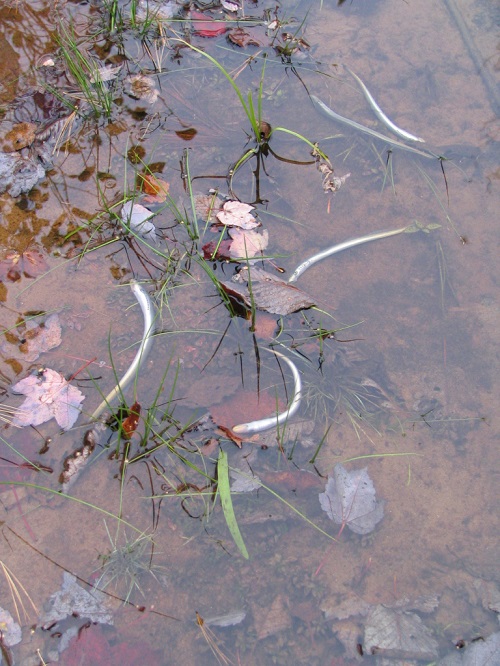
Newly-metamorphosed sea lamprey larvae. They have undergone transformation, as evidenced by the development of eyes and a sucker mouth. Photo credit: Fisheries and Oceans Canada. 4. Working Together to protect our Great Lakes fishery
Understanding the sea lamprey’s life cycle helps scientists deliver an effective control program.
Government agencies work in consultation with non-governmental organizations and the fishing public to improve our fishery. In 1955, Canada and the United States created the Great Lakes Fishery Commission to control sea lampreys, coordinate research, and improve the fishery. This cooperative approach has succeeded since 1955.
For More Information
If you would like to learn more about sea lamprey control, contact the Great Lakes Fishery Commission, the Sea Lamprey Control Centre or the partner nearest you.
- Great Lakes Fishery Commission
2100 Commonwealth Blvd., Ste. 100
Ann Arbor, MI 48105
734-662-3209 - Fisheries and Oceans Canada
Sea Lamprey Control Centre
1219 Queen Street East
Sault Sainte Marie, ON P6A 2E5
705-941-3000 | Toll-free: 800-553-9091 | Fax: 705-941-3025 - U.S. Geological Survey
Hammond Bay Biological Station
11188 Ray Road
Millersburg, MI 49759
989-734-4768 - Upper Midwest Science Center
2630 Fanta Reed Road
LaCrosse, WI 54602
608-783-6451 - U.S. Fish and Wildlife Service
Ludington Biological Station
229 S. Jebavy Drive
Ludington, MI 49431
231-845-6205 - U.S. Fish and Wildlife Service
Marquette Biological Station
3090 Wright Street
Marquette, MI 49855
906-226-6571
This content was produced in cooperation with the Ontario Federation of Anglers and Hunters and the Great Lakes Sport Fishing Council, key partners in protecting our fishery.
- Great Lakes Fishery Commission
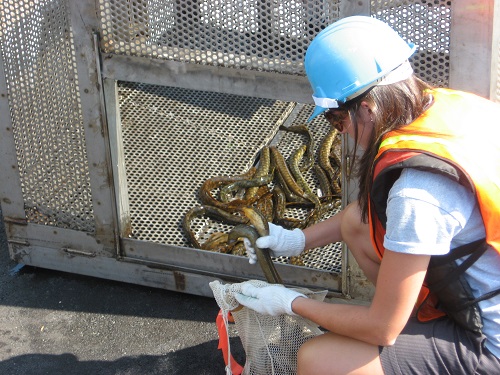
No comments:
Post a Comment